formerly eScholarship Editions


|
|
|
|
Your search for
'California and the West' in subject
found 104 book(s). | Modify Search | Displaying 21 - 40 of 104 book(s) | |
| 21. | 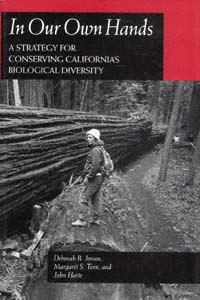 | Title: In our own hands: a strategy for conserving California's biological diversity Author: Jensen, Deborah B Published: University of California Press, 1993 Subjects: Environmental Studies | Ecology | Public Policy | California and the West Publisher's Description: "Biodiversity." As argument over environmental and conservation policy grows more heated in California and throughout the nation, the term has become a buzzword. But what does biodiversity really mean? What really threatens it? Why should we care? In Our Own Hands offers a readable, scientifically sound view of California's biological diversity and what must be done to preserve it. The book will be an invaluable resource for environmental and natural resource specialists, educators, and general readers.Local and global forces threaten California's wetlands, dunes, oak woodlands, and riparian forest habitats - all declining habitats in a rapidly urbanizing, culturally heterogeneous, and politically turbulent state. Always a bellwether, California will be a model for the rest of the United States in its scientific and political solutions to conservation problems. This book proposes the first steps toward a unified national conservation policy for the twenty-first century. [brief] Similar Items |
| 22. | 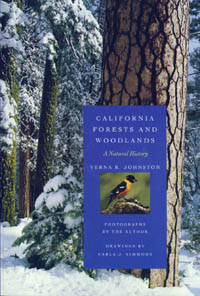 | Title: California forests and woodlands: a natural history Author: Johnston, Verna R Published: University of California Press, 1994 Subjects: Environmental Studies | Science | Ecology | Biology | California and the West Publisher's Description: From majestic Redwoods to ancient Western Bristlecone Pines, California's trees have long inspired artists, poets, naturalists - and real estate developers. Verna Johnston's splendid book, illustrated with her superb color photographs and Carla Simmons's detailed black-and-white drawings, now offers an unparalleled view of the Golden State's world-renowned forests and woodlands.In clear, vivid prose, Johnston introduces each of the state's dominant forest types. She describes the unique characteristics of the trees and the interrelationships of the plants and animals living among them, and she analyzes how fire, flood, fungi, weather, soil, and humans have affected the forest ecology. The world of forest and woodland animals comes alive in these pages - the mating games, predation patterns, communal life, and the microscopic environment of invertebrates and fungi are all here.Johnston also presents a sobering view of the environmental hazards that threaten the state's trees: acid snow, ozone, blister rust, over-logging. Noting the interconnectedness of the diverse life forms within tree regions, she suggests possible answers to the problems currently plaguing these areas. Enriched by the observations of early naturalists and Johnston's many years of fieldwork, this is a book that will be welcomed by all who care about California's treasured forests and woodlands. [brief] Similar Items |
| 23. | 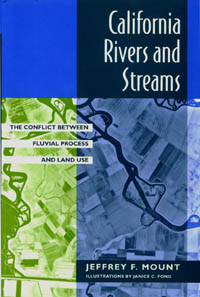 | Title: California rivers and streams: the conflict between fluvial process and land use Author: Mount, Jeffrey F 1954- Published: University of California Press, 1995 Subjects: Environmental Studies | California and the West | Ecology | Geography Publisher's Description: California Rivers and Streams provides a clear and informative overview of the physical and biological processes that shape California's rivers and watersheds. Jeffrey Mount introduces relevant basic principles of hydrology and geomorphology and applies them to an understanding of the differences in character of the state's many rivers. He then builds on this foundation by evaluating the impact on waterways of different land use practices - logging, mining, agriculture, flood control, urbanization, and water supply development.Water may be one of California's most valuable resources, but it is far from being one we control. In spite of channels, levees, lines and dams, the state's rivers still frequently flood, with devastating results. Almost all the rivers in California are dammed or diverted; with the booming population, there will be pressure for more intervention.Mount argues that Californians know little about how their rivers work and, more importantly, how and why land-use practices impact rivers. The forceful reconfiguration and redistribution of the rivers has already brought the state to a critical crossroads. California Rivers and Streams forces us to reevaluate our use of the state's rivers and offers a foundation for participating in the heated debates about their future. [brief] Similar Items |
| 24. | 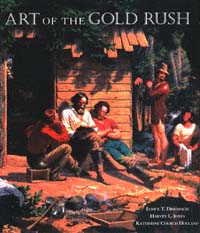 | Title: Art of the gold rush Author: Driesbach, Janice Tolhurst Published: University of California Press, 1998 Subjects: Art | California and the West | Californian and Western History Publisher's Description: The California Gold Rush captured the get-rich dreams of people around the world more completely than almost any event in American history. This catalog, published in celebration of the sesquicentennial of the 1848 discovery of gold at Sutter's Mill, shows the vitality of the arts in the Golden State during the latter nineteenth century and documents the dramatic impact of the Gold Rush on the American imagination.Among the throngs of gold-seekers in California were artists, many self-taught, others formally trained, and their arrival produced an outpouring of artistic works that provide insights into Gold Rush events, personages, and attitudes. The best-known painting of the Gold Rush era, C.C. Nahl's Sunday Morning in the Mines (1872), was created nearly two decades after gold fever had subsided. By then the Gold Rush's mythic qualities were well established, and new allegories - particularly the American belief in the rewards of hard work and enterprise - can be seen on Nahl's canvas. Other works added to the image of California as a destination for ambitious dreamers, an image that prevails to this day. In bringing together a range of art and archival material such as artists' diaries and contemporary newspaper articles, The Art of the Gold Rush broadens our understanding of American culture during a memorable period in the nation's history. [brief] Similar Items |
| 25. | 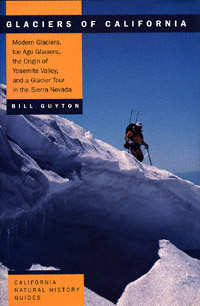 | Title: Glaciers of California: modern glaciers, ice age glaciers, origin of Yosemite Valley, and a glacier tour in the Sierra Nevada Author: Guyton, Bill 1932- Published: University of California Press, 1998 Subjects: Science | Geology | Natural History | California and the West | Geography Publisher's Description: Glaciers in sunny California? Many people will be surprised to learn that there are several hundred in this state, ranging in size from the impressive Whitney Glacier on Mt. Shasta and the Palisade Glacier in the Sierra Nevada to tiny glacierets. While California's glaciers are small compared to those in the northern Rockies or the European Alps, each one is interesting and some are suitable for exploring. Also of note is the fact that Ice Age glaciers carved California's most spectacular mountain scenery - the High Sierra was glaciated several times and glacial landforms are prominent features of the Sierran landscape today.Bill Guyton summarizes the history of the discovery of Ice Age glaciation and modern-day glaciers in California, as well as the development of modern ideas about the state's glacial history. He describes the controversy about the origin of Yosemite Valley and quotes from the colorful accounts of early mountain explorers such as John Muir, Josiah Whitney, and François Matthes. His book provides a primer on glaciers and glacial landforms, a glossary of technical terms, helpful illustrations, and a 100-mile Sierra field trip guide for readers who want to see glaciers and glacial features for themselves. Glaciers of California will make any visit to the mountains more interesting, whether one is carrying a camera, crampons, or a fishing pole. [brief] Similar Items |
| 26. | 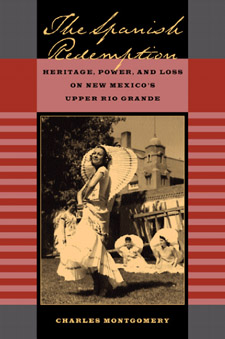 | Title: The Spanish redemption: heritage, power, and loss on New Mexico's upper Rio Grande Author: Montgomery, Charles H 1964- Published: University of California Press, 2002 Subjects: History | United States History | Latino Studies | California and the West Publisher's Description: Charles Montgomery's compelling narrative traces the history of the upper Rio Grande's modern Spanish heritage, showing how Anglos and Hispanos sought to redefine the region's social character by glorifying its Spanish colonial past. This readable book demonstrates that northern New Mexico's twentieth-century Spanish heritage owes as much to the coming of the Santa Fe Railroad in 1880 as to the first Spanish colonial campaign of 1598. As the railroad brought capital and migrants into the region, Anglos posed an unprecedented challenge to Hispano wealth and political power. Yet unlike their counterparts in California and Texas, the Anglo newcomers could not wholly displace their Spanish-speaking rivals. Nor could they segregate themselves or the upper Rio Grande from the image, well-known throughout the Southwest, of the disreputable Mexican. Instead, prominent Anglos and Hispanos found common cause in transcending the region's Mexican character. Turning to colonial symbols of the conquistador, the Franciscan missionary, and the humble Spanish settler, they recast northern New Mexico and its people. [brief] Similar Items |
| 27. | 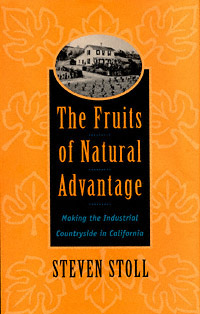 | Title: The fruits of natural advantage: making the industrial countryside in California Author: Stoll, Steven Published: University of California Press, 1998 Subjects: History | Californian and Western History | Environmental Studies | California and the West | Labor Studies Publisher's Description: The once arid valleys and isolated coastal plains of California are today the center of fruit production in the United States. Steven Stoll explains how a class of capitalist farmers made California the nation's leading producer of fruit and created the first industrial countryside in America. This brilliant portrayal of California from 1880 to 1930 traces the origins, evolution, and implications of the fruit industry while providing a window through which to view the entire history of California.Stoll shows how California growers assembled chemicals, corporations, and political influence to bring the most perishable products from the most distant state to the great urban markets of North America. But what began as a compromise between a beneficent environment and intensive cultivation ultimately became threatening to the soil and exploitative of the people who worked it.Invoking history, economics, sociology, agriculture, and environmental studies, Stoll traces the often tragic repercussions of fruit farming and shows how central this story is to the development of the industrial countryside in the twentieth century. [brief] Similar Items |
| 28. | 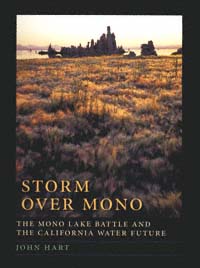 | Title: Storm over Mono: the Mono Lake battle and the California water future Author: Hart, John 1948- Published: University of California Press, 1996 Subjects: Environmental Studies | Environmental Studies | Natural History | California and the West Publisher's Description: A dramatic environmental saga unfolds in John Hart's compelling story of the fight to save Mono Lake. This ancient inland sea, in the eastern Sierra near Yosemite National Park, is among the oldest in North America. But over the past fifty years, as its feeder streams were steadily drained to supply water to ever-growing, ever-thirsty Los Angeles, the lake's water volume eventually was reduced by half. Mono Lake's bizarre but productive ecosystem began to collapse: salinity greatly increased, nesting and migrating birds were threatened, and fierce alkali dust storms became a common occurrence.Then, in the mid-1970s, a handful of people, most of them students with minimal financial resources, began a campaign to save the dying lake. They took on not only Los Angeles but the entire state government and a whole way of thinking about water. Their fight seemed doomed in the beginning, but long years of grassroots education and effort finally paid off. In 1994, the California Water Resources Control Board ruled that Los Angeles's use of Mono Lake's waters be restricted. Over time, the lake will return to a healthy condition.John Hart integrates natural, social, and political history into a story that is a source of hope for anyone concerned about the environment. Storm over Mono demonstrates the important role of science in public policy debates and validates the concept of the public trust, the idea that certain things belong to us all, not metaphorically but in simple legal fact.Complementing Hart's narrative are 32 stunning color photographs by a dozen leading nature photographers, along with numerous black-and-white photographs, illustrations, and maps. [brief] Similar Items |
| 29. | 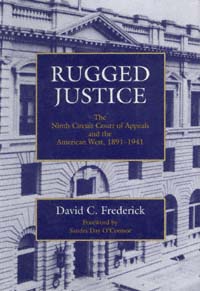 | Title: Rugged justice: the Ninth Circuit Court of Appeals and the American West, 1891-1941 Author: Frederick, David C Published: University of California Press, 1994 Subjects: History | History | United States History | Californian and Western History | California and the West | Law Publisher's Description: Few chapters in American judicial history have enjoyed as colorful a past as has the U.S. Court of Appeals for the Ninth Circuit. Created in 1891, its jurisdiction now encompasses California, Oregon, Nevada, Washington, Idaho, Montana, Arizona, Hawaii, and Alaska. David Frederick has mined archival sources, including court records and legal papers throughout the West and in Washington, D.C., to document the Ninth Circuit's first fifty years. His findings are much more than a record of the court, however, for they also provide a unique social and cultural history of the West.During these years, the court heard key cases involving railroads, the Alaska gold rush, Chinese immigration, organized labor, and use of natural resources. Many of the decisions from this period foreshadowed issues that are with us today. Frederick also documents the court's part in Western development and in issues relating to World War I, Prohibition, New Deal legislation, and the evolving role of federal judges.Frederick portrays the West's most important judicial institution with clarity and intelligence, reminding us that the evolution of the Ninth Circuit both reflected and affected the dramatic changes occurring in the West during the court's early years. This is a book that will appeal not only to lawyers, but to historians, sociologists, and general readers as well. [brief] Similar Items |
| 30. | 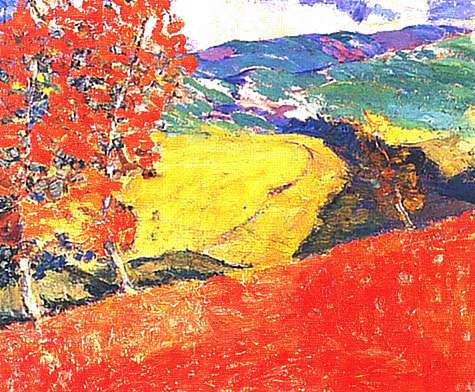 | Title: The Society of Six: California colorists Author: Boas, Nancy 1934- Published: University of California Press, 1997 Subjects: Art | Art History | California and the West | Californian and Western History Publisher's Description: Six plein-air painters in Oakland, California, joined together in 1917 to form an association that lasted nearly fifteen years. The Society of Six - Selden Connor Gile, Maurice Logan, William H. Clapp, August F. Gay, Bernard von Eichman, and Louis Siegriest - created a color-centered modernist idiom that shocked establishment tastes but remains the most advanced painting of its era in Northern California. Nancy Boas's well-informed and sumptuously illustrated chronicle recognizes the importance of these six painters in the history of American Post-Impressionism.The Six found themselves in the position of an avant garde not because they set out to reject conventionality, but because they aspired to create their own indigenous modernism. While the artists were considered outsiders in their time, their work is now recognized as part of the vital and enduring lineage of American art. Depression hardship ended the Six's ascendancy, but their painterliness, use of color, and deep alliance with the land and the light became a beacon for postwar Northern California modern painters such as Richard Diebenkorn and Wayne Thiebaud. Combining biography and critical analysis, Nancy Boas offers a fitting tribute to the lives and exhilarating painting of the Society of Six. [brief] Similar Items |
| 31. | 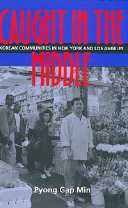 | Title: Caught in the middle: Korean merchants in America's multiethnic cities Author: Min, Pyong Gap 1942- Published: University of California Press, 1996 Subjects: Sociology | Ethnic Studies | Urban Studies | American Studies | California and the West | Social Problems Publisher's Description: In this unflinching exploration of one of the most politically charged topics of our time, Pyong Gap Min investigates the racial dynamics that exist between Korean merchants, the African American community, and white society in general. Focusing on hostility toward Korean merchants in New York and Los Angeles, Min explains how the "middleman" economic role Koreans often occupy - between low-income, minority customers on the one hand and large corporate suppliers on the other - leads to conflicts with other groups. Further, Min shows how ethnic conflicts strengthen ties within Korean communities as Koreans organize to protect themselves and their businesses.Min scrutinizes the targeting of Korean businesses during the 1992 Los Angeles riots and the 1990 African American boycotts of Korean stores in Brooklyn. He explores Korean merchants' relationships with each other as well as with Latin American employees, Jewish suppliers and landlords, and government agencies. In each case, his nuanced analysis reveals how Korean communities respond to general scapegoating through collective action, political mobilization, and other strategies.Fluent in Korean, Min draws from previously unutilized sources, including Korean American newspapers and in-depth interviews with immigrants. His findings belie the media's sensationalistic coverage of African American-Korean conflicts. Instead, Caught in the Middle yields a sophisticated and clear-sighted understanding of the lives and challenges of immigrant merchants in America. [brief] Similar Items |
| 32. | 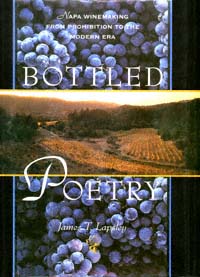 | Title: Bottled poetry: Napa winemaking from Prohibition to the modern era Author: Lapsley, James T Published: University of California Press, 1997 Subjects: History | California and the West | United States History | Californian and Western History | Viticulture | Wine Publisher's Description: California's Napa Valley is one of the world's premier wine regions today, but this has not always been true. James Lapsley's entertaining history explains how a collective vision of excellence among winemakers and a keen sense of promotion transformed the region and its wines following the repeal of Prohibition. Focusing primarily on the formative years of Napa's fine winemaking, 1934 to 1967, Lapsley then concludes with a chapter on the wine boom of the 1970s, placing it in a social context and explaining the role of Napa vineyards in the beverage's growing popularity.Names familiar to wine drinkers occur throughout these pages - Beaulieu, Beringer, Charles Krug, Christian Brothers, Louis Martini, Inglenook - and the colorful stories behind the names give this book a personal dimension. These strong-willed, competitive winemakers found ways to work cooperatively, both in sharing knowledge and technology and in promoting their region. The result was an unprecedented improvement in wine quality that brought with it a new reputation for the Napa Valley.In The Silverado Squatters , Robert Louis Stevenson refers to wine as "bottled poetry," and although Stevenson's reference was to the elite vineyards of France, his words are appropriate for Napa wines today. Their success, as Lapsley makes clear, is due to much more than the beneficence of sun and soil. Craft, vision, and determination have played a part too, and for that, wine drinkers the world over are grateful. [brief] Similar Items |
| 33. | 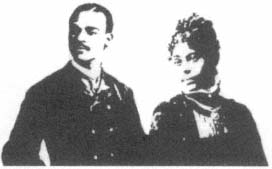 | Title: Pioneer urbanites: a social and cultural history of Black San Francisco Author: Daniels, Douglas Henry Published: University of California Press, 1991 Subjects: American Studies | African American Studies | Social Problems | California and the West | United States History Publisher's Description: The black migration to San Francisco and the Bay Area differed from the mass movement of Southern rural blacks and their families into the eastern industrial cities. Those who traveled West, or arrived by ship, were often independent, sophisticated, single men. Many were associated with the transportation boom following the Gold Rush; others traveled as employees of wealthy individuals.Douglas Daniels argues for the importance of going beyond the written record and urban statistics in examining the life of a minority community. He has studied photographs from family albums and interviewed members of old black San Francisco families in his effort to provide the first nuanced picture of the lives of black San Franciscans from the 1860s to the 1940s. [brief] Similar Items |
| 34. | 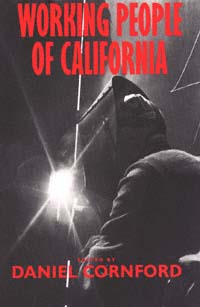 | Title: Working people of California Author: Cornford, Daniel A 1947- Published: University of California Press, 1995 Subjects: History | Ethnic Studies | California and the West | Labor Studies | Californian and Western History Publisher's Description: From the California Indians who labored in the Spanish missions to the immigrant workers on Silicon Valley's high-tech assembly lines, California's work force has had a complex and turbulent past, marked by some of the sharpest and most significant battles fought by America's working people. This anthology presents the work of scholars who are forging a new brand of social history - one that reflects the diversity of California's labor force by paying close attention to the multicultural and gendered aspects of the past. Readers will discover a refreshing chronological breadth to this volume, as well as a balanced examination of both rural and urban communities.Daniel Cornford's excellent general introduction provides essential historical background while his brief introductions to each chapter situate the essays in their larger contexts. A list of further readings appears at the end of each chapter. [brief] Similar Items |
| 35. | 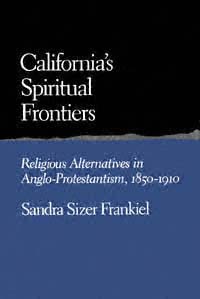 | Title: California's spiritual frontiers: religious alternatives in Anglo-Protestantism, 1850-1910 Author: Frankiel, Sandra Sizer 1946- Published: University of California Press, 1988 Subjects: History | Californian and Western History | California and the West | Christianity Publisher's Description: In this fascinating work, Frankiel examines California's rich, multi-faceted religious history during the period in which the state was taking shape on the American landscape. Similar Items |
| 36. |  | Title: To place our deeds: the African American community in Richmond, California, 1910-1963 Author: Moore, Shirley Ann Wilson 1947- Published: University of California Press, 2000 Subjects: History | Californian and Western History | California and the West | African American Studies Publisher's Description: To Place Our Deeds traces the development of the African American community in Richmond, California, a city on the San Francisco Bay. This readable, extremely well-researched social history, based on numerous oral histories, newspapers, and archival collections, is the first to examine the historical development of one black working-class community over a fifty-year period.Offering a gritty and engaging view of daily life in Richmond, Shirley Ann Wilson Moore examines the process and effect of migration, the rise of a black urban industrial workforce, and the dynamics of community development. She describes the culture that migrants brought with them - including music, food, religion, and sports - and shows how these traditions were adapted to new circumstances. Working-class African Americans in Richmond used their cultural venues - especially the city's legendary blues clubs - as staging grounds from which to challenge the racial status quo, with a steadfast determination not to be "Jim Crowed" in the Golden State.As this important work shows, working-class African Americans often stood at the forefront of the struggle for equality and were linked to larger political, social, and cultural currents that transformed the nation in the postwar period. [brief] Similar Items |
| 37. | 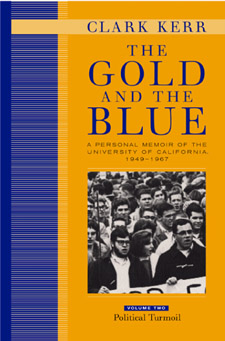 | Title: The gold and the blue: a personal memoir of the University of California, 1949-1967 Author: Kerr, Clark 1911- Published: University of California Press, 2003 Subjects: Autobiographies and Biographies | California and the West | History | Intellectual History Publisher's Description: The Los Angeles Times called the first volume of The Gold and the Blue "a major contribution to our understanding of American research universities." This second of two volumes continues the story of one of the last century's most influential figures in higher education. A leading visionary, architect, leader, and fighter for the University of California, Clark Kerr was chancellor of the Berkeley campus from 1952 to 1958 and president of the university from 1958 to 1967. He saw the university through its golden years - a time of both great advancement and great conflict. This absorbing memoir is an intriguing insider's account of how the University of California rose to the peak of scientific and scholarly stature and how, under Kerr's unique leadership, it evolved into the institution it is today. In Volume II: Political Turmoil, Kerr turns to the external and political environment of the 1950s and 1960s, contrasting the meteoric rise of the University of California to the highest pinnacle of academic achievement with its troubled political context. He describes his attempts to steer a middle course between attacks from the political Right and Left and discusses the continuing attacks on the university, and on him personally, by the state Un-American Activities Committee. He provides a unique point of view of the Free Speech Movement on the Berkeley campus in the fall of 1964. He also details the events of January 1967, when he was dismissed as president of the university by the Board of Regents. [brief] Similar Items |
| 38. | 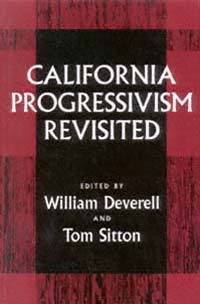 | Title: California progressivism revisited Author: Deverell, William Francis Published: University of California Press, 1994 Subjects: History | Politics | United States History | Californian and Western History | California and the West Publisher's Description: California was perhaps the most important locus for the development of the Progressive reform movement in the decades of the twentieth century. These twelve original essays represent the best of the new scholarship on California Progressivism. Ranging across a spectrum that embraces ethnicity, gender, class, and varying ideological stances, the authors demonstrate that reform in California was a far broader, more complicated phenomenon than we have previously understood.Since the 1950s, scholars have used California Progressivism as a model case study for explaining early twentieth-century social and political reform nationwide. But such a model - which ignored issues of class, race, and gender - simplified a political movement that was, in fact, quite complex.In revising the monolithic interpretation of reform and reformers, this volume provides a better understanding of the sweeping reform impulses that had such a profound effect on American political and social institutions during this century. Equally important, the issues examined here offer significant insights into problems that the entire country must tackle as we approach the new century. [brief] Similar Items |
| 39. | 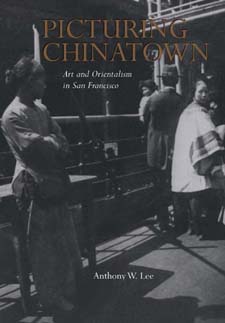 | Title: Picturing Chinatown: art and orientalism in San Francisco Author: Lee, Anthony W 1960- Published: University of California Press, 2001 Subjects: Art | California and the West | Asian American Studies | Photography | Art History Publisher's Description: This visually and intellectually exciting book brings the history of San Francisco's Chinatown alive by taking a close look at images of the quarter created during its first hundred years, from 1850 to 1950. Picturing Chinatown contains more than 160 photographs and paintings, some well known and many never reproduced before, to illustrate how this famous district has acted on the photographic and painterly imagination. Bringing together art history and the social and political history of San Francisco, this vividly detailed study unravels the complex cultural encounter that occurred between the women and men living in Chinatown and the artists who walked its streets, observed its commerce, and visited its nightclubs. Artistic representations of San Francisco's Chinatown include the work of some of the city's most gifted artists, among them the photographers Laura Adams Armer, Arnold Genthe, Dorothea Lange, Eadweard Muybridge, and Carleton Watkins and the painters Edwin Deakin, Yun Gee, Theodore Wores, and the members of the Chinese Revolutionary Artists' Club. Looking at the work of these artists and many others, Anthony Lee shows how their experiences in the district helped encourage, and even structured, some of their most ambitious experiments with brush and lens. In addition to discussing important developments in modern art history, Lee highlights the social and political context behind these striking images. He demonstrates the value of seeing paintings and photographs as cultural documents, and in so doing, opens a fascinating new perspective on San Francisco's Chinatown. [brief] Similar Items |
| 40. | 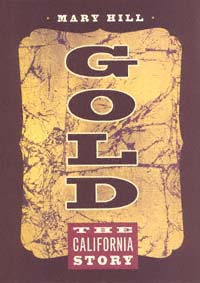 | Title: Gold: the California story Author: Hill, Mary 1923- Published: University of California Press, 2000 Subjects: California and the West | Californian and Western History | Geology | Natural History Publisher's Description: The discovery of gold in 1848 catapulted California into statehood and triggered environmental, social, political, and economic events whose repercussions are still felt today. Mary Hill combines her scientific training with a flair for storytelling to present the history of gold in California from the distant geological past through the wild days of the Gold Rush to the present.The early days of gold fever drew would-be miners from around the world, many enduring great hardships to reach California. Once here, they found mining to be backbreaking work and devised machines to help recover gold. These machines pawed gravel from river bottoms and tore apart mountainsides, wreaking environmental havoc that silted rivers, ruined farmlands, and provoked the world's first environmental conflict settled in the courts. Native Americans were nearly wiped out by invading miners or their diseases, and many Spanish-speaking settlers - Californios - were pushed aside.Hill writes of gold's uses in today's world for everything from coins to coffins, gourmet foods to spacecraft. Her comprehensive overview of gold's impact on California includes illustrated explanations of geology and mining in nontechnical language as well as numerous illustrations, maps, and photographs. [brief] Similar Items |